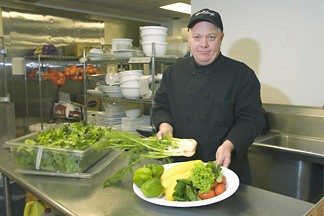Cornell Dining triples purchases from local farmers as long-distance food supply system faces rising pressures
By Krishna Ramanujan
Think globally, act locally.
Considering rising fossil fuel prices, global warming, the impacts of multinational corporations on local economies and the fact that most of the food we purchase in supermarkets is shipped thousands of miles, perhaps nowhere is this modern adage more relevant than when making the decision to buy and eat local foods.
Cornell Dining has begun to put its considerable spending power into supporting state and regional farmers by directing its fruits and vegetables supplier, Ithaca Produce, to buy 20 percent of its food locally -- within a 100-mile radius. That's a strong input into the local economy, considering Cornell spends around $9 million a year on food for its 31 dining locations across campus. Steven Miller, senior executive chef for Cornell Dining, estimates that in September the North Star dining hall at Appel Commons spent about $225,000 on food purchases, while Robert Purcell's community center dining hall's food expenses totaled around $200,000. This year the university's dining system is buying around 23 percent of food locally compared with 7 percent in 2005. The goal is to boost that percentage up to 30 percent by next year, Miller said.
"When a large institution like Cornell says we want to buy locally grown foods, that sends a strong economic signal to our local farmers," said Jennifer Wilkins, senior extension associate in the Division of Nutritional Sciences and director of Cornell's Farm to Schools program. Noting that the program is working with Cornell Dining to plan a more sustainable, local-food purchasing plan, she said, "When any institution buys locally it is really serving the public good."
When Cornell buys local produce, the money has a multiplying effect in the local economy. Farmers who get paid a dollar for their produce can then spend that dollar locally again to pay a farmhand. In this way, a dollar can circulate several times in a community. But money spent on foods imported from outside the region exits immediately from the local economy.
"A lot of food in the Northeast is transported from all over the globe," said Gil Gillespie Jr., a senior research associate in the Department of Development Sociology and acting director of the Community, Food and Agriculture Program. An Iowa State University study found that food imported into Iowa travels an average distance of 1,300 miles, Gillespie said. Miller added that the cost of one truck moving food from coast to coast averages close to $10,000. Such a system reduces freshness, and with rising oil prices and the impacts of exhaust fumes from trucks on global climate change, it may not be sustainable.
At the same time, the short Northeast growing season creates challenges for local growers and consumers interested in supporting local agriculture.
"Our percentage of local produce is much higher during summer months like August than during the winter months of January, February and March," said Miller. "If we were in California, it would be a much different situation."
To offset a limited winter selection, Miller said, Cornell Dining strives later in the year to buy local produce with a longer shelf life -- such as cabbage, carrots, potatoes and other root vegetables and apples. Buyers also purchase greens from a local indoor hydroponic lettuce farm.
Local food can cost more because local farms tend to be small, perhaps even less than 10 acres, compared with the 10,000-acre California farms that grow in vast monocultures and can charge less, said Miller. But Cornell Dining supports the higher price as long as the students are willing to pay for the fresher, more sustainable local product.
Simply finding enough produce is another challenge for a large institution that acts locally. "When you are feeding four people, it is easy to buy locally," said Miller. "When you're feeding 24,000 people a day, it becomes very different." For example, Cornell sometimes has to purchase from four or five farmers just to get enough beans for a meal.
Right now, Cornell Dining is focused on increasing its local produce purchases, without too much thought of buying local organic foods, which can cost on average 20 percent to 40 percent more than nationally marketed nonorganic products. For instance: Antibiotic-free chicken breast from a local producer is $6.50 a pound, compared with conventional drug-treated white meat that costs $1.50 a pound, said Miller.
The bottom line: Given all the choices, local or organic food is only feasible if people are willing to pay the price. "Ultimately, the students need to make that decision," he said.
Media Contact
Get Cornell news delivered right to your inbox.
Subscribe